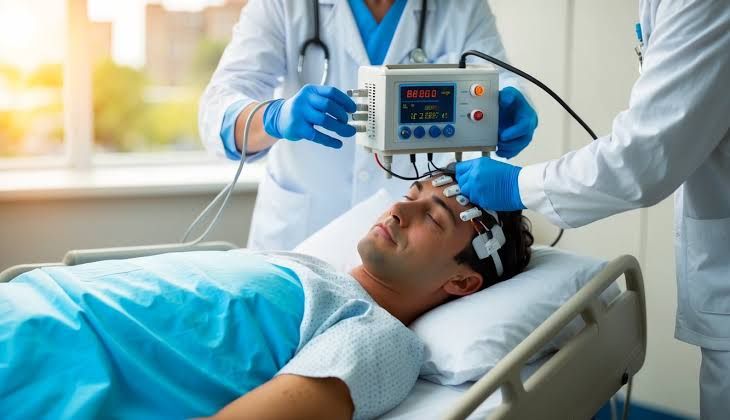
Indications for Electroconvulsive Therapy (ECT)
Electroconvulsive Therapy (ECT) is primarily indicated for severe psychiatric conditions, particularly when other treatments have failed or are not appropriate. The main indications include:
- Major Depressive Disorder: ECT is often used in cases of severe depression, especially when there is a risk of suicide or when rapid response is necessary.
- Bipolar Disorder: It can be effective for both depressive and manic episodes, particularly in treatment-resistant cases.
- Schizophrenia: ECT may be considered for patients with schizophrenia who have severe symptoms that do not respond to medication.
- Catatonia: This condition, characterized by motor immobility and behavioral abnormality, can respond rapidly to ECT.
- Neuroleptic Malignant Syndrome: ECT may be used as a treatment option in this life-threatening condition associated with antipsychotic medications.
Physiologic Effects of ECT
The physiologic effects of ECT are complex and involve several systems within the body:
- Neurological Effects: ECT induces a controlled seizure that alters brain chemistry, leading to increased levels of neurotransmitters such as serotonin, norepinephrine, and dopamine. This alteration can help alleviate symptoms of depression and other mood disorders.
- Cardiovascular Effects: During an ECT session, there is typically an increase in heart rate and blood pressure due to the stress response induced by the seizure activity. However, these changes are usually transient.
- Endocrine Response: ECT can stimulate the hypothalamic-pituitary-adrenal (HPA) axis, which may lead to increased cortisol levels temporarily following treatment.
- Cognitive Effects: While some patients report improvements in cognitive function post-ECT, others may experience short-term memory loss or confusion immediately following treatment.
- Muscle Relaxation and Seizure Activity: Muscle relaxants are administered prior to inducing the seizure to minimize physical movement during the procedure while still allowing for a therapeutic seizure to occur.
Side Effects of ECT
While ECT can be highly effective, it also has potential side effects:
- Cognitive Side Effects:
- Short-term memory loss is common immediately after treatment but typically improves over time.
- Some patients may experience longer-lasting memory issues related to events occurring around the time of treatment.
- Physical Side Effects:
- Headaches and muscle soreness can occur post-treatment due to the seizure activity.
- Nausea may also be experienced as a result of anesthesia or the procedure itself.
- Psychological Side Effects:
- Some individuals may experience anxiety about undergoing the procedure or fear regarding its effects on memory and cognition.
- Cardiovascular Risks:
- Patients with pre-existing heart conditions may face increased risks during treatment due to fluctuations in heart rate and blood pressure.
- Anesthesia-related Risks:
- As ECT requires general anesthesia, there are inherent risks associated with anesthesia itself, including allergic reactions or complications from pre-existing health conditions.
In summary, while Electroconvulsive Therapy is a powerful tool for treating severe mental health disorders with significant physiological effects on brain chemistry and function, it also carries risks that must be carefully managed by healthcare professionals.
Comprehensive overview of Clinical Situations in Which Electroconvulsive Therapy (ECT) May Be the Treatment of Choice
Electroconvulsive Therapy (ECT) is a medical treatment that involves delivering small electrical currents to the brain, intentionally triggering a brief seizure. ECT is primarily used to treat severe mental health conditions when other treatments have failed or are not appropriate. Below are detailed clinical situations where ECT may be considered the treatment of choice:
1. Major Depressive Disorder (MDD)
ECT is particularly effective for patients with severe major depressive disorder, especially when accompanied by psychotic features, such as delusions or hallucinations. It is often indicated for individuals who have not responded to antidepressant medications or psychotherapy. In cases where there is an urgent need for rapid symptom relief—such as in patients at risk of suicide—ECT can provide faster alleviation of depressive symptoms compared to traditional pharmacotherapy.
2. Treatment-Resistant Depression
For patients who have tried multiple antidepressants without success, ECT can be a viable option. Studies show that ECT has a higher response rate than medication alone in treatment-resistant cases, making it a critical intervention for those who suffer from chronic and debilitating depression.
3. Bipolar Disorder
In bipolar disorder, ECT can be particularly beneficial during severe depressive episodes or acute manic episodes when rapid stabilization is required. It may be preferred over medications due to its effectiveness and quicker onset of action, especially in cases where patients cannot tolerate mood stabilizers or antipsychotics due to side effects.
4. Schizophrenia
While antipsychotic medications are the primary treatment for schizophrenia, ECT may be indicated in certain situations, such as when patients experience severe psychotic symptoms that do not respond adequately to medication or when there are concerns about medication adherence. ECT can help alleviate acute psychotic episodes and improve overall functioning.
5. Catatonia
Catatonia is characterized by motor immobility and behavioral abnormality associated with various psychiatric disorders, including schizophrenia and mood disorders. ECT is one of the most effective treatments for catatonia, often leading to rapid improvement in symptoms.
6. Neuroleptic Malignant Syndrome (NMS)
NMS is a life-threatening condition often caused by antipsychotic medications characterized by muscle rigidity, fever, autonomic instability, and altered mental status. In cases where NMS occurs, ECT may be employed as it can help alleviate symptoms more quickly than pharmacological interventions.
7. Severe Post-Traumatic Stress Disorder (PTSD)
Although not first-line therapy for PTSD, ECT may be considered in severe cases where other treatments have failed or if the patient presents with significant functional impairment or suicidal ideation related to their trauma history.
8. Severe Anxiety Disorders
In some instances of severe anxiety disorders—particularly those that are resistant to standard treatments—ECT may be utilized as part of a comprehensive treatment plan aimed at reducing debilitating anxiety symptoms.
In summary, while ECT is not the first-line treatment for most psychiatric conditions due to its invasive nature and potential side effects (such as memory loss), it remains an essential option in specific clinical scenarios where rapid intervention is necessary or when other treatments have proven ineffective.
Pretreatment Assessment for Electroconvulsive Therapy (ECT)
The pretreatment assessment is crucial to ensure patient safety and optimize treatment outcomes. This assessment involves several steps:
- Comprehensive Psychiatric Evaluation: A thorough psychiatric evaluation is essential to confirm the diagnosis and assess the severity of the condition. This includes understanding the patient’s history, current symptoms, previous treatments, and any potential contraindications for ECT.
- Medical History Review: A detailed medical history should be obtained to identify any pre-existing medical conditions that may require special precautions during ECT. Conditions such as cardiovascular disease, respiratory issues, or neurological disorders can influence the decision to proceed with ECT.
- Physical Examination: A complete physical examination is necessary to evaluate the patient’s overall health status. Vital signs should be monitored, and specific attention should be given to heart health due to the potential cardiovascular effects of ECT.
- Laboratory Tests: Routine laboratory tests may include blood tests (e.g., complete blood count, electrolytes) and possibly imaging studies (e.g., ECG) to assess cardiac function. These tests help in identifying any underlying issues that could complicate ECT administration.
- Informed Consent: Patients must be informed about the procedure, its risks, benefits, and alternatives before giving consent. This process ensures that patients understand what ECT entails and can make an informed decision regarding their treatment.
- Assessment of Anesthesia Risks: Since ECT requires general anesthesia, an anesthesiologist will evaluate the patient’s suitability for anesthesia based on their medical history and physical examination findings.
- Special Precautions: Certain conditions require additional precautions:
- Cardiovascular Issues: Patients with a history of heart problems may need closer monitoring or modifications in treatment protocols.
- Neurological Disorders: Individuals with epilepsy or other neurological conditions may require tailored approaches.
- Pregnancy: Pregnant patients need careful consideration due to potential risks to both mother and fetus.
- Medications: A review of current medications is vital as some drugs can interact negatively with ECT or anesthesia.
Medical Care Before, During, and After ECT Treatment
The medical care surrounding ECT encompasses several phases:
1. Before Treatment
- Preoperative Instructions: Patients are typically instructed not to eat or drink for a specified period before the procedure (usually 6-8 hours). This minimizes risks associated with anesthesia.
- Medication Management: Some medications may need to be adjusted or temporarily discontinued prior to ECT; this includes certain antidepressants or anticoagulants that could affect bleeding risk during procedures.
2. During Treatment
- Monitoring During Anesthesia Induction: Once in the treatment room, patients are monitored closely by healthcare professionals as they receive anesthesia.
- Administration of ECT: Electrodes are placed on the scalp according to standard protocols (bitemporal or unilateral placement), followed by controlled electrical stimulation intended to induce a seizure lasting approximately 30-60 seconds.
- Continuous Monitoring: Throughout the procedure, vital signs such as heart rate, blood pressure, oxygen saturation, and EEG activity are continuously monitored.
3. After Treatment
- Post-Anesthesia Recovery: After the procedure, patients are moved to a recovery area where they are monitored until they regain consciousness fully. Vital signs continue to be checked regularly.
- Observation for Side Effects: Common side effects include confusion and temporary memory loss; these should be assessed during recovery.
- Discharge Planning: Once stable, patients are usually discharged home with instructions regarding post-treatment care which may include rest and avoiding driving or operating heavy machinery for a specified time.
- Follow-Up Care: Regular follow-up appointments are scheduled post-treatment to monitor progress and manage any ongoing mental health needs.
In summary, comprehensive pretreatment assessments combined with meticulous medical care throughout all phases of ECT ensure patient safety while maximizing therapeutic benefits.







